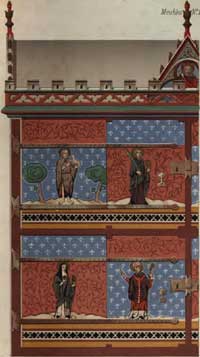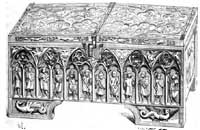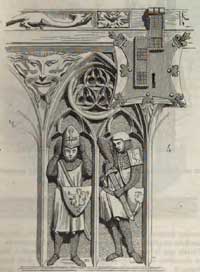French Gothic Furniture
At its debut, the French Gothic furniture was marked by robustness and simplicity, with the pieces intended to keep valuables giving the assurance of a very secure place. Eventually, the Gothic style furniture became more architectural in character, the main ornaments being imported from the art of the Cathedral.
The Gothic carving had a geometrical character, with its ornamentation imported from architecture, and using the typical motifs: the pointed arch, the trefoil and quatrefoil, the wheel, the rose, and the linen-fold.
French Gothic Armoire
Until the end of the 13th century, the armoires were mainly decorated by paintings executed on the doors’ panels, and by elaborated ornamental hinges. At the beginning of the 14th century, the wood was sculpted, and then painted, or gilded. Sometimes, the wood was covered with vellum, gilded, or decorated with embossings and colorful ornaments.

French Gothic Armoire - Noyon Cathedral
The sculpted armoire, covered with paintings and embossings, was a main feature in the castles.
The French furniture of the 14th century is proving that French luxury, which during the 11th and 13th centuries derived exclusively from religious sources, became purely secular.
The cabinet-work of the 14th century shows a high skill of execution, strength and durability. The masters of period were exceptionally gifted wood carvers, notably Pierre of Neufchateau, Jean of Liège, Guillaume of Marcilly, Pierre and Guillaume Picheneau, Philippot Viard.
The French Gothic furniture made by these master cabinet-makers was work of the highest quality, material and execution alike.
One of the most wonderful Gothic furniture cabinets is the one kept in the treasury of Noyon Cathedral, dating from the 13th century. The interior and exterior panels are painted. The exterior paintings are displaying saints on purple and blue background. The interior paintings are showing saints playing different musical instruments, holding censers and chandeliers.
The more humble secular armoires had no other embellishment than the iron bands or hinges, their main purpose being to add to the strength of the construction.
The dresser was one of the most distinctive article of the French Gothic furniture of the 15th century, especially in the houses of the nobility. The delicate carving included representations of the Annunciation and Nativity, or figures of saints and angels, occupying a central position between the folding-doors of the armoire.
Gothic Chests
The nobles and the wealthy citizens used to travel with all their family goods packed in huge chests, which were also serving as furniture at stopping-places. The chests contained various tapestries (according to the period of the year), that were fastened to the walls using hooks and cords, and the coverings for the beds.
One of the most beautiful examples of French Gothic furniture is the chest illustrated on the upper right section of the page. On the outside, beneath the arcades, are carved the figures of the twelve peers of France, dressed for battle. Their costumes help us to identify the period when the chest was made, 1290-1310. The top cover is ornamented with bas-reliefs representing scenes from married life, jugglers, and grotesque animals. The hinges were originally painted.


